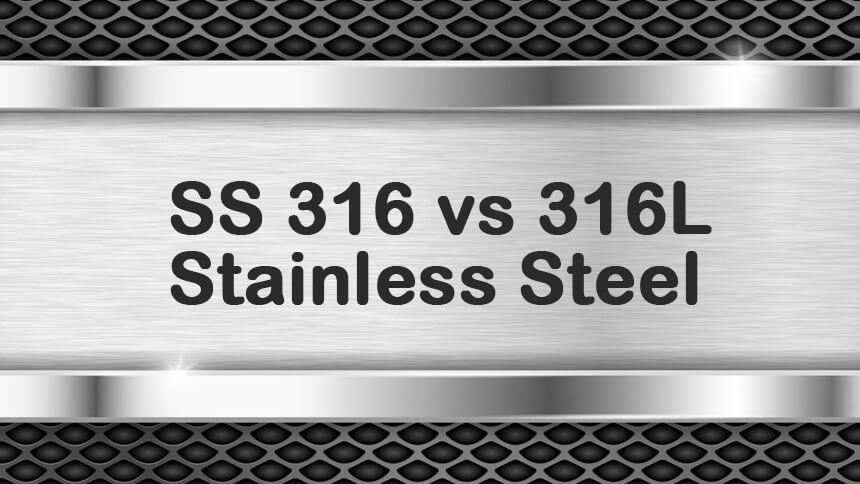There are many types of stainless steel. Then what are the differences between 316 and 316L stainless steel? Check out the following article and you will get the answer.
Performance introduction: Due to the addition of molybdenum, 316 stainless steel has excellent corrosion resistance, atmospheric corrosion resistance and high temperature strength. It can be used under harsh conditions; it has excellent work hardening (non-magnetic).
Scope of application: equipment used in seawater, chemical, dye, paper, oxalic acid, fertilizer and other production equipment; photography, food industry, coastal facilities, ropes, CD rods, bolts, nuts.
316L stainless steel (L is low carbon)
Performance introduction: As a low-carbon series of 316 steel, in addition to the same characteristics as 316 steel, it has excellent grain boundary corrosion resistance.
Scope of application: Products with special requirements for anti-grain boundary corrosion.
1. Performance comparison
Chemical composition

316 and 316L stainless steels are stainless steels containing molybdenum. The molybdenum content in 316L stainless steel is slightly higher than that in 316 stainless steel. Due to the molybdenum in steel, the overall performance of this steel is better than 310 and 304 stainless steel. Under high temperature conditions, when the concentration of sulfuric acid is lower than 15% and higher than 85%, 316 Stainless steel has a wide range of uses. 316 stainless steel also has good chloride corrosion properties, so it is usually used in marine environments. 316L stainless steel has a maximum carbon content of 0.03, which can be used in applications that cannot be annealed after welding and require maximum corrosion resistance.
2. Corrosion resistance
The corrosion resistance of 316 stainless steel is better than that of 304 stainless steel, and it has good corrosion resistance in the production process of pulp and paper. And 316 stainless steel is also resistant to corrosion by the ocean and corrosive industrial atmosphere.
Generally speaking, 304 stainless steel and 316 stainless steel have little difference in chemical corrosion resistance, but they are different under certain specific media.
The stainless steel originally developed is 304. Under certain circumstances, this material is more sensitive to Pitting Corrosion. An additional 2-3% molybdenum can reduce this sensitivity, and thus 316 was born. In addition, these additional molybdenum can also reduce the corrosion of certain hot organic acids.
316 stainless steel has almost become a standard material in the food and beverage industry. Due to the worldwide shortage of molybdenum and the higher nickel content in 316 stainless steel, the price of 316 stainless steel is more expensive than 304 stainless steel.
Pitting corrosion is a phenomenon mainly caused by deposit corrosion on the surface of stainless steel. This is because a protective layer of chromium oxide cannot be formed due to lack of oxygen.
Especially in small valves, the possibility of deposits on the valve plate is very small, so pitting corrosion rarely occurs.
In various types of water media (distilled water, drinking water, river water, boiler water, sea water, etc.), the corrosion resistance of 304 stainless steel and 316 stainless steel is almost the same, unless the content of chloride ions in the medium is very high, then 316 stainless steel is more suitable.
In most cases, the corrosion resistance of 304 stainless steel and 316 stainless steel is not much different, but in some cases it may also be very different, which requires specific analysis. Generally speaking, valve users should have a good idea, because they will choose the material of the container and pipe according to the condition of the medium. It is not recommended to recommend materials to users.

3. Heat resistance
In intermittent use below 1600 degrees and continuous use below 1700 degrees, 316 stainless steel has good oxidation resistance. In the range of 800-1575 degrees, it is best not to continuously act on 316 stainless steel, but when 316 stainless steel is continuously used outside this temperature range, the stainless steel has good heat resistance. 316L stainless steel has better resistance to carbide precipitation than 316 stainless steel, and the above-mentioned temperature range can be used.
4. Heat treatment
Annealing in the temperature range of 1850-2050 degrees, then rapid annealing, and then rapid cooling. 316 stainless steel cannot be hardened by heat treatment.
5. Welding
316 stainless steel has good welding performance. All standard welding methods can be used for welding. During welding, 316Cb, 316L or 309Cb stainless steel filler rods or welding rods can be used according to the application. In order to obtain the best corrosion resistance, the welded section of 316 stainless steel needs to be annealed after welding. If 316L stainless steel is used, post-weld annealing treatment is not required.
Mechanical behavior

Among all steels, austenitic stainless steel has the lowest yield point. Therefore, considering the mechanical properties, austenitic stainless steel is not the best material for the valve stem, because to ensure a certain strength, the diameter of the valve stem will increase. The yield point cannot be increased by heat treatment, but it can be increased by cold forming.
6. Magnetic
Due to the wide application of austenitic stainless steel, it gives people the false impression that all stainless steels are not magnetic. For austenitic stainless steel, it can basically be understood as non-magnetic, which is true for quenched forged steel. But 304 processed by cold forming will be somewhat magnetic. For cast steel, if it is 100% austenitic stainless steel, it has no magnetism.
JM Steel has an area of about 22,000 square meters for the production of large, medium and small diameter stainless steel seamless pipes. We offer one-stop procurement of stainless steel plates, coils, tubes bars, including all shapes and surfaces. Special specifications and materials are guaranteed to be customized. Don't hesitate to contact us!